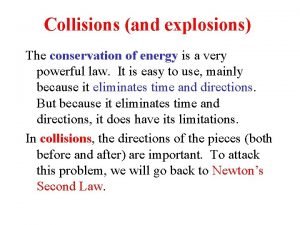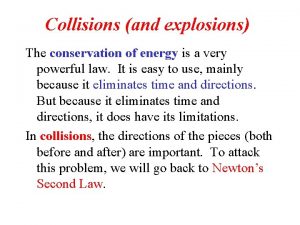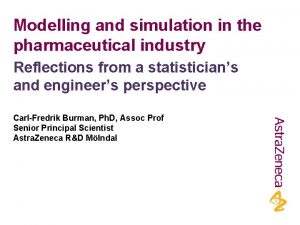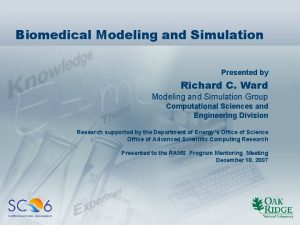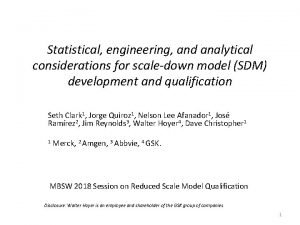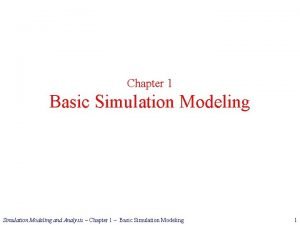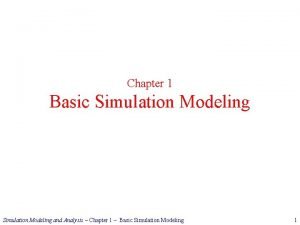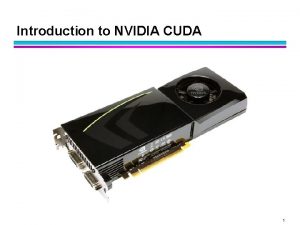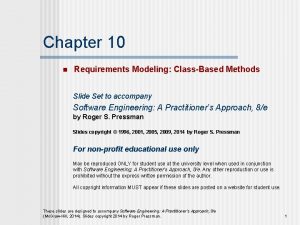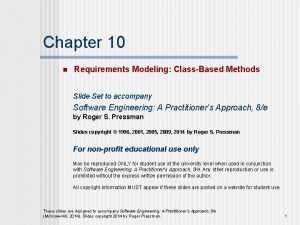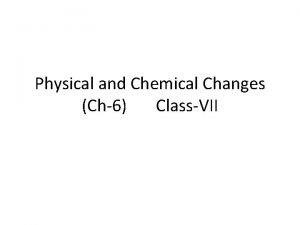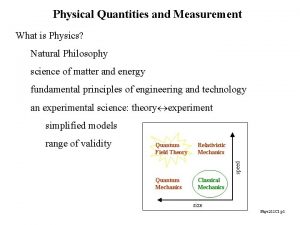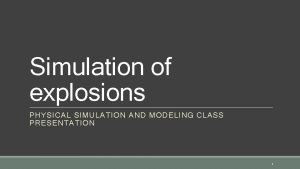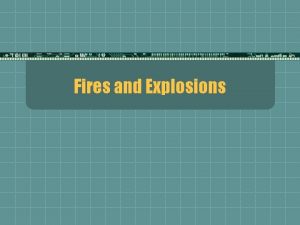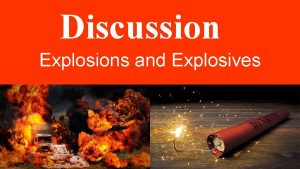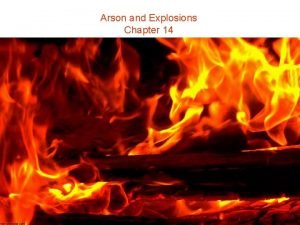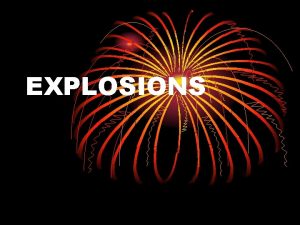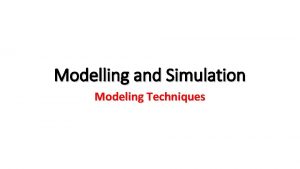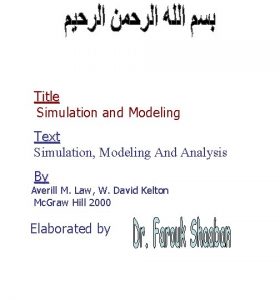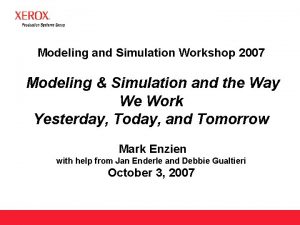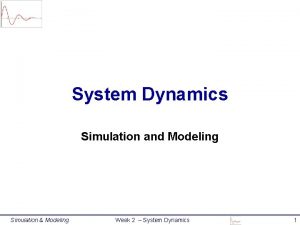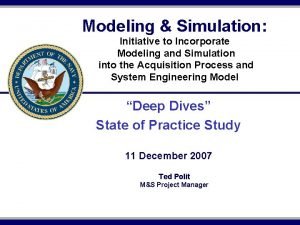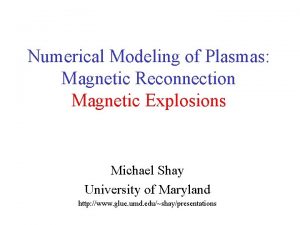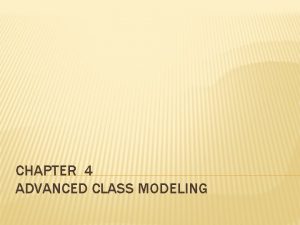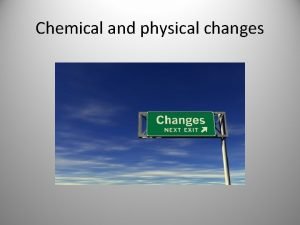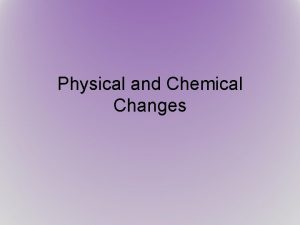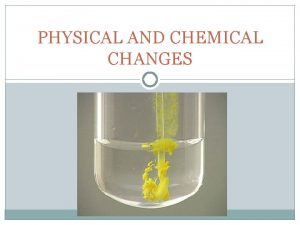Simulation of explosions PHYSICAL SIMULATION AND MODELING CLASS

























- Slides: 25

Simulation of explosions PHYSICAL SIMULATION AND MODELING CLASS PRESENTATION 1

Overview ◦ Introduction ◦ Motivation ◦ Background ◦ Particles ◦ Blast curves ◦ Fluid simulation ◦ Physics of explosions ◦ Mathematical Model ◦ Simulation ◦ Rendering 2

Introduction ◦ Sudden release of energy ◦ Pressure wave ◦ Supersonic speed ◦ Compression of air ◦ Interaction with boundaries ◦ Interesting visual effects 3

Explosions are… ◦ Dangerous ◦ Costly ◦ Difficult to control ◦ Impossible to undo 4

Background - Particles ◦ Earliest attempt by William Reeves ◦ Particle systems for modeling fuzzy objects ◦ Clouds, Fire, Water ◦ Procedural System approach ◦ ◦ Generation Degeneration Transformation of live particles Rendering ◦ Genesis Demo in Star Trek II ◦ Drawbacks ◦ Computationally expensive ◦ Cannot model a continuum 5

Background – Blast curves ◦ One of the first mathematical models of blast waves propagation ◦ Neff and Fume in 1999 ◦ Based on TNT explosion model ◦ Chemical reaction ◦ Violent gas expansion ◦ Formation of compressed air causing a pressure wave 6

Background – Blast curves ◦ Modeling techniques ◦ Full simulation based on NS equations of Fluid dynamics ◦ Simplified equations from Structural engineering research ◦ Approximate the blast wave as a triangular pressure pulse ◦ Modifying the propagation using its distance from explosion center ◦ Isotropic model ◦ Unchanged by obstacles 7

Background – Fluid simulation ◦ Needed to simulate complex phenomenon that reacts to surroundings ◦ Kass and Miller developed a water simulator in 1990 ◦ Modeled only the surface of the fluid ◦ Vastly simplified set of PDEs used for shallow water ◦ Flow primitives ◦ Linearly combined to produce a complex flow ◦ Mimic behavior of flow around obstacles 8

Background – Fluid simulation ◦ In 1996, a system developed using NS equations ◦ ◦ ◦ Couple momentum and mass conservation The domain is divided into a grid of voxels Each cell has a pressure and 3 velocities Transport fluid between cells Relaxation step to achieve stability ◦ Coupling with obstacles allowed to achieve wave effects ◦ ◦ Reflection Refraction Diffraction Rotational effects 9

Physics - Shock front ◦ Ideal blast wave ◦ Still and Homogenous atmosphere ◦ Spherically symmetric pressure source ◦ Can model pressure wave as a function of time and distance from blast center 10

Physics – Diffracted waves ◦ Interaction of shock waves with boundaries and obstacles ◦ Example : Planar shock wave 11

Physics – Mach Stem ◦ Critical angle of incidence ◦ ◦ Beyond which normal, acoustic wave reflection does not occur Reflected wave merges back with incident wave Creates an intense wave front – Mach stem Blasts occurring above ground plane are more destructive 12

Conservation of Mass ◦ Change of fluid density = Net flux across the fluid boundary 13

Conservation of momentum ◦ Navier-Stokes equation Body Forces Pressure gradient Viscous accelerations Convective transportation of momentum v : Flow velocity ρ : Fluid density f : Body forces such as gravity µ : Coefficient of viscosity P : Pressure 14

Conservation of Energy ◦ First law of Thermodynamics ◦ Change in energy = Amount of heat added and the work done to the system ◦ Work done from pressure and viscosity ◦ Heat transferred from thermal conductivity Thermal conduction N : Internal energy per unit mass T : Temperature P : Pressure v : Velocity k : Thermal conductivity ρ : Density Work done by Viscous dissipation pressure Convective term 15

Simulation - Discretization ◦ Regular lattice of cubic cells – voxels ◦ Fluid properties are constant across each voxel ◦ Central finite differences are used to calculate spatial derivatives ◦ Integration Steps ◦ Approximate fluid acceleration at current time ◦ Compute velocity ◦ Approximate change in internal energy using computed velocity ◦ Compute new density ◦ Calculate final v(t + dt) and N(t + dt) using convective terms and new value of density ◦ Update secondary quantities such as temperature 16

Simulation – Boundary Conditions ◦ Hard boundaries ◦ Solid objects ◦ Force fluid velocities normal to them to 0 ◦ Tangential flow is unaffected ◦ Free boundaries ◦ Blast waves travel through ◦ Model slow, long term effects such as fireballs and dust clouds ◦ Pseudo free ◦ For faster execution ◦ Pressure difference less then a threshold -> free boundary ◦ Prunes out majority of the volume for the blast wave expansion 17

Simulation – Initial conditions ◦ Pressure and Temperature ◦ Detonation = Region of volume with high pressure or temperature ◦ A polygon mesh can be specified ◦ Voxelized to the grid ◦ Allows a variety of effects 18

Interaction with rigid bodies 2 – way coupling between solids and fluids ◦ Apply forces from the fluid to each polygonal surface of a rigid body ◦ Compute the voxel representation of the rigid body ◦ Displace fluid based on object movement ◦ Update fluid 19

Fluid to Solid interaction ◦ Hydrostatic pressure ◦ Normal to the surface ◦ Generated by incoherent motion of fluid molecules against the surface ◦ Dynamic forces ◦ Normal and tangent (negligible) to the surface ◦ Coherent motion of continuous fluid Normal force / area Hydrostatic pressure Relative to surface 20

Solid to Fluid interaction ◦ Triangular mesh is converted to voxels ◦ Full cells == Hard boundaries ◦ Partial cells = Modified convection equation according to volume ◦ Forces (from fluid) applied on solid ◦ Rigid body position update -> Revoxelization ◦ Change in volume of partial cells -> Displace fluid ρ : Density V : Velocity P : Pressure T : Temperature γ : 1. 4 for air 21

Rendering ◦ Refraction of light ◦ Bending of light from blast wave ◦ Higher refraction index ◦ Captured by ray-tracing through the fluid volume ◦ Fire balls ◦ Composed of detonated material from inside the explosive ◦ Place particles in the explosion shape specified ◦ Massless and flow with fluid ◦ Each particle has a temperature ◦ Interpolated based on its position in the volume 22

Rendering ◦ Dust clouds ◦ ◦ Blast wave propagates disturbing the particles resting on surfaces Creation rate can be a user-controlled variable Smaller particles : Lower terminal velocities; More Brownian motion Rendered as small spheres with Gaussian density ◦ Variance grows according to Mean Brownian diffusion per unit time 23

References ◦ Reeves, W. T. 1983. Particle systems—a technique for modeling a class of fuzzy objects. ACM Transactions on Graphics 2, (2), 91 -108 ◦ Paramount Pictures. 1982. Star Trek II: The Wrath of Khan(film) ◦ Neff, M. , and Fiume, E. 1999. A visual model for blast waves and fracture. Graphics Interface 99, 193 -202 ◦ Kass, M. , AND Miller, G. 1990. Rapid, stable fluid dynamics for computer graphics. In SIGGRAPH 90 Conference Proceedings. 49 -57 ◦ Wejchert, J. , and Haumann, D. 1991. Animation aerodynamics. In SIGGRAPH 91 Conference Proceedings. 19 -22 ◦ Foster, N. , and Metaxas, D. 1996. Realistic animation of liquids. Graphical Models and Image Processing 58, (5), 471 -483 ◦ Yngve, G. , O’Brien, J. , and Hodgins, J. 2000. Animating explosions. In SIGGRAPH 2000 Conference Proceedings. 29 -36 ◦ Roach, Matthew Douglas, J. 2005. Physically based simulation of explosions. Master’s thesis 24

Thank you 25
 Collisions and explosions
Collisions and explosions Collisions and explosions
Collisions and explosions Helen c. erickson nursing theory
Helen c. erickson nursing theory Relational modeling vs dimensional modeling
Relational modeling vs dimensional modeling Simulation modeling and analysis law kelton
Simulation modeling and analysis law kelton Pharmaceutical simulation and modeling
Pharmaceutical simulation and modeling Introduction to modeling and simulation
Introduction to modeling and simulation Biomedical modeling and simulation
Biomedical modeling and simulation Apa itu simulasi
Apa itu simulasi Modeling and simulation
Modeling and simulation Nature of simulation
Nature of simulation Basic simulation modeling
Basic simulation modeling Computational engineering and physical modeling
Computational engineering and physical modeling Class based modeling in software engineering
Class based modeling in software engineering Class based modeling in software engineering
Class based modeling in software engineering Physical rate fences example
Physical rate fences example Physical fitness grade 9
Physical fitness grade 9 Class 7 chemical and physical change
Class 7 chemical and physical change Physical quantities and measurement class 6 worksheet
Physical quantities and measurement class 6 worksheet Describe data and process modeling concepts and tools
Describe data and process modeling concepts and tools Linear quadratic function
Linear quadratic function Dfd chapter 5
Dfd chapter 5 Difference between abstract class and concrete class
Difference between abstract class and concrete class Difference between abstract class and concrete class
Difference between abstract class and concrete class 7 rights of medication administration in order
7 rights of medication administration in order Static vs dynamic class loading
Static vs dynamic class loading
